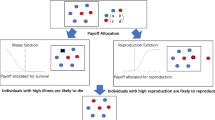Abstract
Evolutionary suicide is an evolutionary process where a viable population adapts in such a way that it can no longer persist. It has already been found that a discontinuous transition to extinction is a necessary condition for suicide. Here we present necessary and sufficient conditions, concerning the bifurcation point, for suicide to occur. Evolutionary suicide has been found in structured metapopulation models. Here we show that suicide can occur also in unstructured population models. Moreover, a structured model does not guarantee the possibility of suicide: we show that suicide cannot occur in age-structured population models of the Gurtin-MacCamy type. The point is that the mutant’s fitness must explicitly depend not only on the environmental interaction variable, but also on the resident strategy.
Similar content being viewed by others
References
Allee, W. C., A. Emerson, T. Park and K. Schmidt (1949). Principles of Animal Ecology, Philadelphia: Saunders.
Darwin, C. (1859). On the Origin of Species by Means of Natural Selection, or the Preservation of Favoured Races in the Struggle for Life, Albemarle Street, London: John Murray.
Darwin, C. (1871). The Descent of Man, and Selection in Relation to Sex, Albemarle Street, London: John Murray.
Diekmann, O., M. Gyllenberg, H. Huang, M. Kirkilionis, J. A. J. Metz and H. R. Thieme (2001). On the formulation and analysis of general deterministic structured population models. II. Nonlinear theory. J. Math Biol. (to appear).
Diekmann, O., M. Gyllenberg, J. A. J. Metz and H. R. Thieme (1998). On the formulation and analysis of general deterministic structured population models. I. Linear theory. J. Math. Biol. 36, 349–388.
Diekmann, O., J. A. P. Heesterbeek and J. A. J. Metz (1990). On the definition and the computation of the basic reproduction ratio R 0 in models for infectious-diseases in heterogeneous populations. J. Math. Biol. 28, 365–382.
Diekmann, O., S. D. Mylius and J. R. ten Donkelaar (1999). Saumon à la Kaitala et Getz, sauce hollandaise. Evol. Ecol. Res. 1, 261–275.
Ferrière, R. (2000). Adaptive responses to environmental threats: evolutionary suicide, insurance, and rescue, in Options, Laxenburg, Austria: IIASA, pp. 12–16.
Geritz, S. A. H., M. Gyllenberg, F. J. A. Jacobs and K. Parvinen (2001). Invasion Dynamics and Attractor Inheritance (submitted).
Geritz, S. A. H., È. Kisdi, G. Meszéna and J. A. J. Metz (1998). Evolutionarily singular strategies and the adaptive growth and branching of the evolutionary tree. Evol. Ecol. 12, 35–57.
Gurtin, M. E. and R. C. MacCamy (1974). Non-linear age-dependent population dynamics. Arch. Rat. Mech. Anal. 54, 281–300.
Gyllenberg, M. and I. A. Hanski (1992). Single-species metapopulation dynamics: a structured model. Theor. Popul. Biol. 42, 35–62.
Gyllenberg, M. and J. A. J. Metz (2001). On fitness in structured metapopulations. J. Math. Biol. (in press).
Gyllenberg, M., K. Parvinen and U. Dieckmann (2000). Evolutionary suicide and evolution of dispersal in structured metapopulations, Interim Report IR-00-056, Laxenburg, Austria: IIASA, http://www.iiasa.ac.at/cgi-bin/pubsrch?IR00056.
Haldane, J. B. S. (1932). The Causes of Evolution, London: Longmans, Green & Co. Limited.
Hardin, G. (1968). The tragedy of the commons. Science 162, 1243–1248.
Heesterbeek, J. A. P. (1992). R 0, PhD thesis, University of Leiden, The Netherlands.
Kisdi, È. (1999). Evolutionary branching under asymmetric competition. J. Theor. Biol. 197, 149–162.
Matsuda, H. and P. A. Abrams (1994a). Runaway evolution to self-extinction under asymmetrical competition. Evolution 48, 1764–1772.
Matsuda, H. and P. A. Abrams (1994b). Timid consumers: self-extinction due to adaptive change in foraging and anti-predator effort. Theor. Popul. Biol. 45, 76–91.
Metz, J. A. J., S. A. H. Geritz, G. Meszéna, F. J. A. Jacobs and J. S. van Heerwaarden (1996). Adaptive dynamics, a geometrical study of the consequenses of nearly faithful reproduction, in Stochastic and Spatial Structures of Dynamical Systems, S. J. van Strien and S. M. Verduyn Lunel (Eds), Amsterdam: North-Holland, pp. 183–231.
Metz, J. A. J. and M. Gyllenberg (2001). How should we define fitness in structured metapopulation models? Including an application to the calculation of ES dispersal strategies. Proc. R Soc. B 268, 499–508.
Mylius, S., M. Doebeli and O. Diekmann (2001). Can initial invasion dynamics correctly predict phenotypic substitutions? in Elements of Adaptive Dynamics, U. Dieckmann and J. A. J. Metz (Eds), Cambridge University Press (in press).
Author information
Authors and Affiliations
Corresponding author
Rights and permissions
About this article
Cite this article
Gyllenberg, M., Parvinen, K. Necessary and sufficient conditions for evolutionary suicide. Bull. Math. Biol. 63, 981–993 (2001). https://doi.org/10.1006/bulm.2001.0253
Received:
Accepted:
Issue Date:
DOI: https://doi.org/10.1006/bulm.2001.0253




